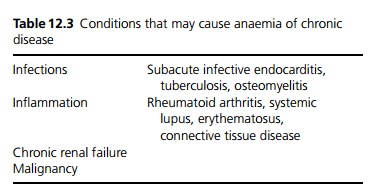Chapter: Medicine and surgery: Haematology and clinical Immunology
Anaemia of chronic disease - Normocytic anaemia
Normocytic anaemia
Anaemia of chronic disease
Definition
Anaemia of chronic disease is a condition of impaired iron use where haemoglobin is reduced but iron stores are normal or high.
Aetiology/pathophysiology
Anaemia may result from any chronic disease, see Table 12.3. The exact mechanisms are unknown but may include the following:
· Bone marrow iron stores are not incorporated into developing erythrocytes.
· There is a relative resistance to erythropoetin.
· Circulating red cells have a reduced life span.
· These changes may be mediated by cytokines such as IL-1, TNF and interferon.

Clinical features
Symptoms and signs of anaemia.
Investigations
The anaemia is usually normocytic but may be slightly microcytic. Serum iron is low but ferritin is normal or high. The total iron binding capacity is low. The ESR is usually raised.
Management
Treating the underlying cause may result in a resolution of the anaemia. Erythropoeitin may be of benefit.
Related Topics